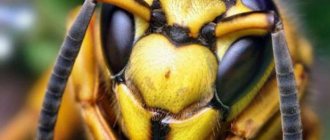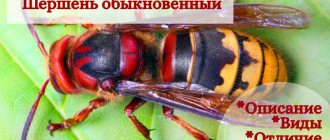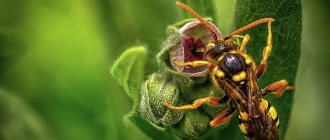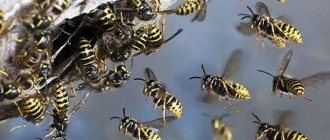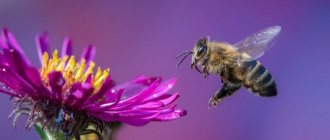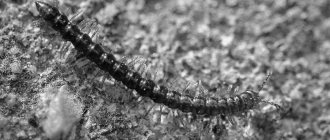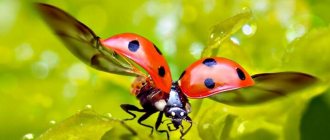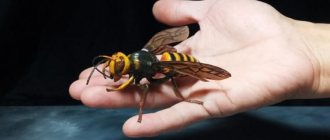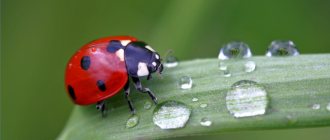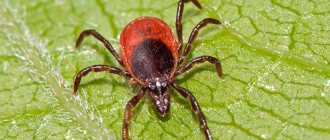The black hornet, or Dybovsky's hornet, is considered a rather rare species compared to some other types of these insects. On the territory of our country they can be found in the Amur region and Transbaikalia. In general, they are also found in Japan, India, Burma, Thailand, Korea and China.
Even in its main habitat areas, this hornet does not live in large numbers. This species does not build its own nests, so their massive presence anywhere in one place is usually not observed. Perhaps this was the reason for its rare and small population. However, the lifestyle of these insects explains a lot.
Habitat and lifestyle
The Dybovsky hornet is considered the rarest insect in Russia. Its numbers are small. You can meet him in Transbaikalia, and if you’re lucky, in the Amur region. The most common dipteran is in China, Thailand, Japan, and Korea.
This is interesting! The black hornet is able to penetrate and take over the nest of smaller relatives.
In general, if you look at the habitat, it cannot be said that there are very few insects. They just can live in favorable environments to increase their numbers. This species is widespread in Asia. The insects are rare in Europe. The behavioral characteristics of insects make them few in number in any particular habitat. Hornets have a stable population.
The only nest parasite among its brothers
The most important and especially interesting feature in which black hornets differ from other hornets is their way of life. Of all 23 species of its fellows, the black one is the only nest parasite.
At the end of summer, a young female finds a fairly overgrown nest of common or medium-sized Japanese hornets, penetrates it and kills the queen.
After this, the female invader, using special pheromones, disguises herself as family members, whose individuals, guided by smell, immediately recognize her as their queen. Despite the fact that the new resident of the nest belongs to a completely different species, the workers, confused by her smell, begin to serve the new queen with the same zeal.
After capturing the nest, the female black hornet immediately begins to lay pre-fertilized eggs, from which individuals are then hatched that are already capable of reproduction. Thus, throughout the entire development of the larvae of one species, they are nurtured by misled workers of another.
When the number of females and males becomes sufficient, they leave the nest and mate. The males soon die, and the females find places for wintering or, if it happens in the tropics, new families for parasitism.
In the photo there is a black hornet on the bark of a tree:
It is worth noting that capturing a nest, despite the simple algorithm, is not easy for female black hornets. The vast majority of them die at the “hands” of working individuals who zealously defend their home.
Until the old queen is killed, the new one is never recognized in the family. However, those rare lucky ones who manage to win the nest ensure the appearance of such a number of young individuals that more than covers the death of the less fortunate sisters.
It is clear that single females looking for a nest are not seen as often as, say, numerous working individuals of a large family. That is why, even in their usual habitats, black hornets, unlike hornets of other species, are not considered widespread.
In exceptional cases, these insects can organize their own nests and live in families. This behavior manifests itself extremely rarely and is explained primarily by the fact that in some places of the hornets’ range there may not be other small species at all. In this case, the search for an object for parasitism will definitely end in failure, and even the likely presence of larger species of hornets on the territory will not save the situation: black hornets are not capable of parasitizing on relatives such as giant hornets.
It is also useful to read: What to do if you are bitten by a hornet and how dangerous it can be to your health
Nutrition and reproduction
Adults feed on the nectar of flowers and can attack someone else's hive in search of food. They also love ripe berries and fruits, sometimes making them unsuitable for further use.
The new offspring eat differently. Animal protein is needed for their development. Adult insects catch various flies, small wasps and bees for their larvae. Then they chew all this, and give the resulting food to the larvae. Those, in turn, secrete a substance with a sweet taste in the form of droplets that hornets like.
This is interesting! A special feature of the black hornet is its ability to live and develop in other people's nests.
In the autumn, the female begins to look for a home for breeding new offspring. She watches tree insects and selects a smaller species, after which she attacks the queen. If she manages to win the battle for her place of residence, then she gets new hornets with dark brown or blue wings. However, there may be many soldier hornets in the nest, which fiercely defend their queen's right to rule the colony.
After a change of owner, the new individual secretes special substances that help it disguise itself as a dead insect. The worker hornets mistake her for their queen and continue to live in the hive as usual.
Next, the female lays eggs, from which larvae later emerge. Working insects feed them until they grow into adults. Later mating occurs, and some of the hornets die. Females leave the destroyed nest and go in search of a new home.
It is not often that you see hornets building their own home and living in peace and harmony. This is possible if there is no other nest in the area that can be occupied. With a long search, mass death of hornets can occur.
Life cycle
The lifestyle can be called parasitic.
Place
In autumn, the female looks for other people's nests. The female individual selects the smallest representatives and attacks their uterus, killing it.
Starting a family
The queen disguises herself as the murdered queen. This is possible due to the release of a special substance. The workers consider her to be the queen. She successfully runs the colony. If there are a sufficient number of soldiers in the nest, then the female may not achieve her goal; she will not be allowed to take over someone else’s place.
Appearance of larvae
The queen lays eggs either in a newly created nest or in the one she entered. After a while, larvae appear. Working hornets obtain food for their offspring. The larvae form and the mating period begins. After this, some of the individuals die.
What does a hornet look like?
Visually, scolias are very similar to hornets: they have the same dark color and belong to the same family. Its main difference from an ordinary representative of the family is its color. But what about the Dybovsky hornet, because it also has a dark body color. Scientists say that large scolius has two transverse orange stripes on its abdomen. However, not everyone knows this feature and therefore can confuse insects.
Quite often, scolias are mistaken for a hornet. The optimal length of scolius is 45 mm, but sometimes it reaches 60 mm. There is no need to navigate by the length of the insect.
Scolia gigantea - a wasp from the Red Book
Description of the species
Black hornet.
Body size is from 1.8 to 3.5 cm. In rare cases, it can reach 5 cm. The insect has a black body color and dark wings. The wings come with a blue tint.
At the end of the belly there is an ovipositor. It performs the function of a sting. The difference from its relatives is the absence of transverse stripes and a completely dark body. There are no yellow spots on the body.
Hornet danger
Knowing what a black hornet looks like can help you avoid encountering it. An insect bite is much more painful than an ordinary one. If we compare the black with the Asian, the latter type causes much more pain and consequences from the bite. The Asian hornet is a large insect with a painful sting that can cause tissue swelling (Vespa Mandarinia: royal murder hornet (Asian) is written in more detail in the article here). The venom of the Asian hornet is toxic.
If a colony of such insects attacks a person, this can lead to adverse consequences. The reaction from a bite can vary. The composition of the black hornet's venom differs from that of the ordinary one. The toxicity of the black hornet is much lower than that of the Asian hornet.
The poison contains the following components:
- bradykinin;
- histamine;
- antigens;
- formic acid.
The hornet itself does not attack a person just like that. This usually occurs when the hive is damaged by humans. You should not touch the hornets’ home if they suddenly settled in your summer cottage. After the main housewife leaves the house, it can be removed. A hornet can sting several times.
How dangerous are black hornets?
If we talk about black hornet attacks on humans, we can say that this insect stings much more painfully than the common hornet we are used to. But at the same time, its bite is not as terrible as, for example, the sting of a giant Asian hornet, which lives in approximately the same territories.
The fact that the giant hornet is the leader over the black hornet in terms of the toxicity of the poison is an indisputable fact, because this insect, in principle, is one of the most poisonous insects on Earth. But why then, having approximately the same size, do the other two hornets - black and common - sting differently?
The fact is that in order to succeed in capturing the nest, the female black hornet must be able to kill the host queen with her bite. However, theoretically, the old female should be resistant to the conqueror’s poison, because they both belong to the same genus and have toxins similar in composition. However, nature, having “taught” black hornets to parasitize, rewarded them with a special poison containing additional enzymes and toxins, without which victory over the old queen would have been impossible.
As for a person, for him an encounter with a black hornet ends in much the same way as with any other poisonous insect: first of all, a very strong throbbing pain occurs. Immediately after the bite, progressive inflammation appears in the affected area, the tissues harden, and severe itching may be felt. In addition, a stung person often experiences increased heart rate and shortness of breath.
If an allergic reaction joins the main symptoms, severe pain in the head appears, the mucous membranes swell, and the development of Quincke's edema becomes possible. In approximately 5-6% of cases, after a black hornet bite, anaphylactic shock occurs, in which the lack of immediate medical attention can lead to death.
This is interesting
Scolia bites, unlike black hornet bites, are low-risk and practically painless. This is explained by the fact that the first insect uses its poison for protection, so its bite should cause quick and acute pain. The second uses its toxin to immobilize the victim, and it is for this reason that, of all the possible active components, its poison contains predominantly paralytic substances.
First aid for a black hornet sting should include all standard actions in such cases, namely:
- a cold compress should be applied to the affected area as soon as possible;
- to exclude or alleviate a possible allergic reaction, you need to drink Suprastin or another antihistamine and carefully monitor your own condition;
- If you experience headaches, dizziness, or high fever, you should immediately call an ambulance or look for any other way to get to the hospital.
Remember - sensitivity to insect venom in no way depends on your physical condition.
In conclusion, it is impossible not to mention that, like most of its relatives, the black hornet is a peace-loving insect; it will sting a person only in self-defense. If you do not touch this insect, do not try to kill it and do not make sudden movements near the nest, it will never attack first.
At the same time, this hornet is able to provide invaluable help in the garden: it kills various agricultural pests with great pleasure. So take care of rare black hornets, respect their right to exist and use their services to exterminate harmful insects free of charge!
Useful video about the dangers of hornet bites and first aid rules for the victim
First aid for bites
If no reaction appears in the first hours after the bite, then medical procedures can be avoided.
If unfavorable symptoms appear, it is advisable to perform the following actions:
- Treat the bite site with hydrogen peroxide, a solution of potassium permanganate and ammonia prepared in a ratio of 1:5. If this is not at hand, you can rinse with plenty of water.
- To prevent rapid absorption of the venom, apply ice or a cooling pack to the bite site. You can also fill a heating pad with ice water and apply it to the affected area.
- To eliminate the appearance of too strong painful sensations, the bite site is sprinkled with acetylsalicylic acid powder. You can also use herbal ingredients: plantain leaf, dandelion juice, parsley root or leaves. Applying a piece of onion to the affected area also helps.
- If you are bitten by an insect, drink as much fluid as possible. It is advisable to drink clean still water.
What not to do if bitten
If you have suffered from a hornet bite, do not try to take revenge on it by killing it, since in stressful situations the insect released releases substances that attract other representatives.
In addition, it is necessary to avoid consuming alcoholic beverages on the day of the bite, since alcohol dilates blood vessels, which leads to rapid penetration of poison into the blood. To prevent infection and inflammation of the skin, do not scratch the wound or treat it with water from a natural reservoir.
Symptoms and consequences of a bite
After a bite, the following symptoms are possible:
- throbbing severe pain;
- cardiopalmus;
- feeling of shortness of breath;
- severe itching.
Also, in more sensitive people, swelling of the mucous membranes and headache are added to these symptoms. Quincke's edema is possible, although it is rare.
Providing first aid
Even an unqualified person can provide assistance.
You just need to follow these steps:
- Place ice on the bite site.
- To avoid an allergic reaction, give the victim anti-allergy medications. These are Cetrin, Suprastin or Tavegil tablets. To provide a faster effect, it is better to administer the antihistamine intramuscularly.
- Carefully monitor the victim; at the slightest development of severe swelling, you must call an ambulance.
Allergic reaction
All people react differently to the penetration of foreign substances into the body. A person may develop a response despite being in good health.
Approximately 6% of the population develops anaphylactic shock after being bitten. This condition requires mandatory medical care.
Allergy symptoms:
- severe reaction to the bite;
- swelling of soft tissues and mucous membranes;
- anaphylactic shock.
Hornet in the house: how to drive it away
Any action against the hornet family will be dangerous. You can call a special company that removes nests of dangerous insects. There are such offers on the Internet. You can try to eliminate the nest yourself. In case of independent work, you will need to take precautions: use clothes that cannot be pierced by the hornet's ovipositor, closed shoes, rubber gloves, a thick hat and provide face protection. Glasses will not be enough. A protective mask may not help either - an evil individual can easily get under it. The ideal option is a mosquito net.
There are two ways to get rid of dangerous neighbors in your home: kill all the insects or try to drive them away. The choice depends on the degree of your anger at the doomed family. By the way, in Europe the state protects hornets and even imposes a fine for destroying nests...
Extermination activities
The fight against hornets is carried out using insecticides - these are pesticides for killing insects. In this case, you can use any household aerosol to kill flying insects for internal treatment of domestic premises. You can use specialized preparations for use on private farms. For example, you can purchase the following drugs:
— Gel Osoyed. The drug is sold in the gardening departments of supermarkets. A specialized remedy against hornets, wasps and flies. It has no odor to humans, but it contains additives that attract insects. It is produced in the form of a gel, which is applied to substrates - cardboard or other auxiliary material. The gel contains a dye, so it is easy to dose. The product does not dry out for a long time. Cardboards are placed in the path of summer hornets. Insects die within a few minutes from contact with the gel. The substrates with gel are changed when filled with insects.
— Aerosol “From wasp nests ” Mosquitall. The drug is sold in household chemical departments. This is a specialized product for destroying wasp nests (and hornets are wasps). Effective instantly. It can be sprayed from a considerable distance, ensuring safety, since the jet hits a distance of up to 6 meters.
— Aerosol Insecta . The drug is sold in departments for gardeners. This is an instant action insecticide. It will be effective against hornets and many other insects - flies, fleas, ants, bedbugs, cockroaches, moths, earwigs, butterflies, crickets, silverfish, woodlice.
— Aerosol “From flies, wasps ” Dr. Klaus . The drug is sold in household chemical departments. Effective against hornets, wasps and flies.
Preparations to combat hornets
How to drive away or scare away hornets
It is very difficult to drive away hornets. You need to use a repellent (a substance that drives away insects), then remove and destroy the nest. The method is not easy. Don't forget about protective measures. In order to drive away the hornets, you can use insect repellent aerosols (which are sold against mosquitoes, ticks and other insects for application to clothing) or try a regular aerosol deodorant. In both cases, you will have to spray more than one container. If you manage to drive away the hornets, the nest must be immediately removed and destroyed. Along with the nest, you will have to destroy the eggs, larvae and pupae of the hornets.
If you decide to drive away hornets in late autumn, remember that hornets do not overwinter in a nest. When cold weather sets in, the nest can be safely removed.
If the female hornets were not destroyed along with the nest, then they most likely went to winter somewhere nearby. This means that in the spring of next year there is a high probability that they will appear to build a new home. Therefore, the place already favored by hornets will need to be remembered to be treated with a drug that will scare away the females from building a new home. You will also have to observe the entire construction.
Hunting tactics of giant hornets
All months, from spring to colder weather in autumn, from early morning to late evening, Asian hornets hunt to obtain food for the larvae developing in the nest. Flying through the forest, scouts look for small insects, as well as bee hives. Having discovered them, they mark them with a special substance containing odorous pheromones. The attractive aroma attracts worker hornets, which kill the entire population of the colony and take away the honey and larvae.
On a note!
According to scientists, in one hunting operation, aggressive “conquerors” can destroy a colony of 30 thousand bees. However, the inhabitants of the hive do not always give up without a fight; sometimes they manage to kill the scout before the signal is given and can save their offspring from death. To do this, they lure it inside the hive, where, using vibration of the wings, they increase the air temperature to +50ºС, which causes overheating and death of the scout hornet.
For a lone insect caught on the road by a “hunter”, there is no way to escape. When attacked, the predator manages to quickly inject a paralyzing poison, and then chews the prey with its powerful jaws. It only takes a few seconds to decapitate a praying mantis, which is larger than an Asian wasp.
How do hornets differ from wasps and bees?
The hornet and the wasp are, although closely related, still different types of social insects. There are not many differences between them. First of all, hornets are much larger. There are also significant differences in body coloration. The feeding habits and lifestyle of these insects are similar. Wasp nests are smaller and usually spherical in shape.
Giant wasps have much less in common with bees. As already mentioned, the bee’s stinger has serrations and, after it stings, the weapon of defense remains in the body of the victim, after which the insect usually dies. This occurs when a bee stings an object with soft skin. The honey insect can pierce the chitinous shell of a beetle or bug several times without harm to itself.
Externally, a hornet and a bee are so different that it is impossible to confuse them. Smaller bees have a fairly uniform brownish color and a characteristic body fur. Bees feed on the nectar of plant flowers; they have no predatory instincts. These insects do not build nests - even wild individuals live in tree hollows.
And finally, bees produce honey, but giant wasps are not able to do this even if they wanted to.
Benefits and harms
Hornets are useful in that they destroy insects, making it easier for gardeners to combat garden pests, but the hornets' usefulness ends when they settle in apiaries.
Hornets - a thunderstorm of bees
In autumn, honey bees become the main food of hornets - other insects already die at this time.
When raiding hives, one hornet can eat about 30 bees in a day.
When uninvited guests appear, beekeepers try to get rid of them by all possible means.
Being too close to hornets can also be dangerous for humans. An insect bite causes burning pain and can provoke severe allergic reactions.
The bite can be dangerous to humans
Consequences
When attacking, a hornet can bite one or more times. A single bite is not as dangerous to humans as multiple bites. Getting large amounts of insect venom under your skin can cause serious problems.
After a hornet attack, a person experiences intoxication of the body, which leads to the following consequences:
- dizziness, headache, signs of nausea and vomiting.
- fever and chills, sweating.
- difficulty breathing, shortness of breath, in rare cases, convulsions.
The consequences may vary in severity. It depends on the type of hornet, on the person’s immune system, on his age and sensitivity to allergens. Children are the most susceptible to hornet venom. The most dangerous consequence of a hornet attack can be Quincke's edema and anaphylactic shock.
Help with a bite
There are several first aid rules for a hornet sting that will help minimize the consequences of an attack by the largest wasp. The sequence of actions is as follows:
- Examine the bite site and remove sting particles with tweezers, if any.
- Carefully squeeze out the insect venom.
- Wash the wound with soap and then wipe it with a solution of alcohol or potassium permanganate.
- Apply cold.
- Take an antihistamine.
You don’t need to visit a doctor if the hornet has bitten you only once and there is no deterioration in the victim’s condition. However, you should consult a doctor if the following signs are present:
- severe pain and extensive swelling of the bite site,
- weakness and severe manifestations of allergies,
- attack by several hornets at the same time,
- The victim's age is under 16 years.
How to Avoid a Bite
The hornet attacks only when it senses danger to itself or its nest. At the first threat, it releases a special substance - an alarm pheromone, which serves as an attack signal for other individuals. Therefore, you should not kill the hornet near the nest. Hornets,
sensing the smell of danger, the whole family can attack the offender of their relative.
It is advisable to destroy hornet nests only in cases where they threaten bees or their nests are located too close to housing. If the insects have built their home where they will not be disturbed, there is no need to be afraid of their attack. On the contrary, they will even become assistants in protecting the crop from others.
Of course, the hornet can be dangerous to humans. However, you can coexist peacefully with it, if you take into account its habits and characteristics. It is also better not to come close to it and not disturb its nest.
And it is important to remember that in nature there is nothing superfluous, which means it is better to protect hornets rather than destroy them.
Who can be confused with
The “black” and “eastern” species of insects have the same body shape, but different colors. The habitats do not overlap: the species Vespa Orientalis, that is, the eastern hornet, lives west of the Urals.
Oriental
The Ural mountain range is home to a single species of hornet called Vespa Crabro. Details are covered in Chapter 1.
Typical mistakes:
- The great red hornet is either a Vespa Mandarina, the largest species, or the queen eastern hornet Orientalis. Area: in the first case - the Far East, in the second - the west.
- The blue-winged black hornet is not a member of the genus Vespa, but a species of solitary bee. Name: carpenter, carpenter bumblebee, Xylocope.
Of the above mentioned species, two species are listed in the Red Book - Xylocopa Violacea and Vespa Dybowskii. However, representatives of all species can sting. But on condition that the individual is not a male.
Appearance and structure of Vespa Mandarinia
In general, the appearance and body structure of the Asian giant murder hornet are very similar to the characteristic features of representatives of all 23 species of these insects. They resemble wasps in color, but differ from them in size and lifestyle.
You can distinguish the Asian hornet from all other insects by the following striking features:
- Incredibly large size, reaching a ratio of body length and wingspan of 5x7 cm. An adult insect with outstretched wings almost completely covers a woman’s palm and at first glance seems like a plastic toy.
- The abdomen (back part of the body), painted in alternating black and yellow stripes, appears black from a distance because the dark stripes are wider than the light ones.
- The chest (middle part of the body) is very dark, with a characteristic black pattern.
- The head (front part of the body) is most often a rich yellow or orange color, which allows you to notice the insect from afar.
- The paired lateral eyes are very large, deep dark in color, almost black.
In addition to the large lateral eyes, in the center of the front part of the hornet’s head there are three additional ones, thanks to which the insect distinguishes the degree of illumination and is perfectly oriented in space. The Asian hornet sees well even in the dark.
The appearance of the giant insect is very remarkable; the hornet is difficult to confuse with other species or not to notice. But, given the high speed that it can develop when flying, bright identifying signs are not always enough to avoid an unpleasant meeting with the killer, as this eastern giant is also called.
A disaster for humans or a decoration of nature
In a global sense, giant Asian hornets are, of course, dangerous to people, but this danger is not critical, since it is entirely provoked by man himself. These insects are not very aggressive by nature; they will only attack in self-defense or protecting a nest.
Photo 14.
Hornets cause much more damage to apiaries, especially those where less aggressive European honey bees are bred. Sometimes hornets manage to destroy an entire bee family in a few hours, and therefore local beekeepers wage an ongoing systematic fight against them.
In general, the mortality rate from giant hornet bites is quite high: in some regions, up to 100 people die per year. But in fairness, it should be said that most of the dead are the same beekeepers who, without special means of protection, actively destroy hornet nests and, as a result, fall under their massive attacks.
A simple tourist who accidentally finds himself in the forest next to the Vespa Mandarinia hornet should not be afraid of this insect - it will not attack without a reason.
Photo 15.
In the West, many dietary supplements add synthetic substances similar to the secretion contained in developing hornet larvae. These components are believed to increase human endurance. However, there is no experimental evidence for these claims.
In conclusion, it should be noted that for wildlife, giant hornets are one of the most active natural orderlies. They successfully destroy many forest and agricultural pests, therefore, in most biocenoses - including agricultural lands - they are useful and deserve protection.
Photo 16.
Photo 17.
Photo 18.
Photo 19.
Photo 20.
Several dozen hornets completely destroyed a bee hive
https://youtube.com/watch?v=t6gpCqWgaBc%3Fwmode%3Dopaque%26wmode%3Dopaque
https://youtube.com/watch?v=CkZInqR3Qb0%3Fwmode%3Dopaque%26wmode%3Dopaque
sources
https://klop911.ru/shershni-i-osy/shershni/shershen-vespa-mandarinia.html
Huge Asian Hornet
Asian giant hornet (lat. Vespa mandarina)
The original article is on the website Link to the article from which this copy was made.
Building a nest
A hornet's nest or hornet cocoon is the same perfect natural structure as an anthill or termite mound.
A hornet's nest that you shouldn't go near!
The construction of a home always occurs according to the plan inherent in the instincts of insects. The queen begins to build a nest, then workers join in. Gradually, the structure takes on its finished shape. Its dimensions reach 30-50 cm in width and 50-70 cm in length. An empty nest can weigh one kilogram.
There is a complex infrastructure inside the nest. The home is divided into cells, which are analogous to rooms, and compartments, which can be compared to entrances. The owner, the queen hornet, moves around inside the nest, laying eggs in free cells.
